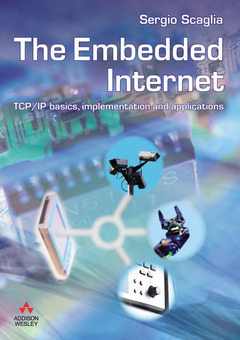The embedded internet with cd, tcp/ip basics, implementation and application
Auteur : SCAGLIA Sergio

In The Embedded Internet Sergio Scaglia examines the techniques that programmers will need to learn to obtain internet connectivity for their embedded systems. Sometimes this will be relatively straight-forward, using TCP/IP stack implementations which already exist. Sometimes, this will be much more difficult, requiring whole new implementations to be developed. Either way, The Embedded Internet will be the ideal starting place for programmers to learn and develop these skills.
The book is structured in three parts. The first part comprehensively covers TCP/IP. This gives the reader the necessary background knowledge of the internet that they will need when considering embedded systems connectivity. The second part details how to implement embedded internet systems. The third and final part gives a conceptual overview of just a handful of the countless ways in which internet connectivity can benefit an embedded system.
Date de parution : 10-2005
Ouvrage de 400 p.



